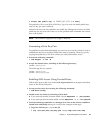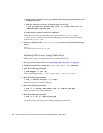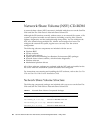
62 Sun Fire V20z and Sun Fire V40z Servers, Server Management Guide • May, 2004
■ Data for each column is left-aligned with at least one space between columns.
Numeric data might be right-aligned.
■ The -D argument allows you to specify a delimiter character when scripting. This
is very useful in parsing fields with white space.
■ If all lines have the same number and type of data values, each row is printed to
a separate line so variable data can be parsed easily. For example, executing
access get users -g monitor returns a list of monitor users each on a
separate line.
■ Commands that return multiple columns (such as inventory get hardware) may
have a minimal default set of columns and a --verbose argument to display all
columns. Some commands include arguments that allow you to select specific
columns to output.
Other Tips For Best Results
■ Externalize the set of SP IP addresses into a file to be shared across all of your
scripts.
■ Consider using a script to create the initial manager account and upload its public
key on your SPs.
■ Test the output and return codes of each command manually by using SSH to log
in to the SP and run the commands individually.
■ Test your scripts on a single staging machine before applying them to your
remaining machines.
■ To configure all of your SPs identically, consider configuring a single SP and then
using the sp load settings command to synchronize that configuration on
the remaining machines.
Note – If running the script from the SP, there are a limited number of commands
(not a full bash environment).


















